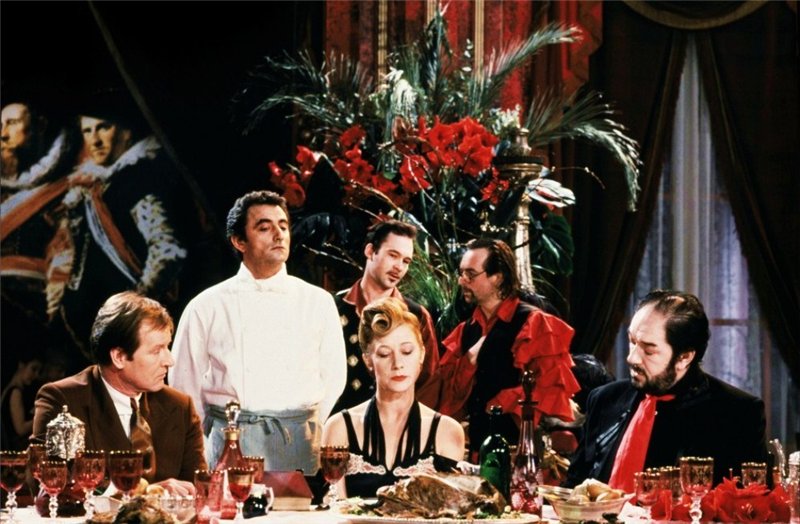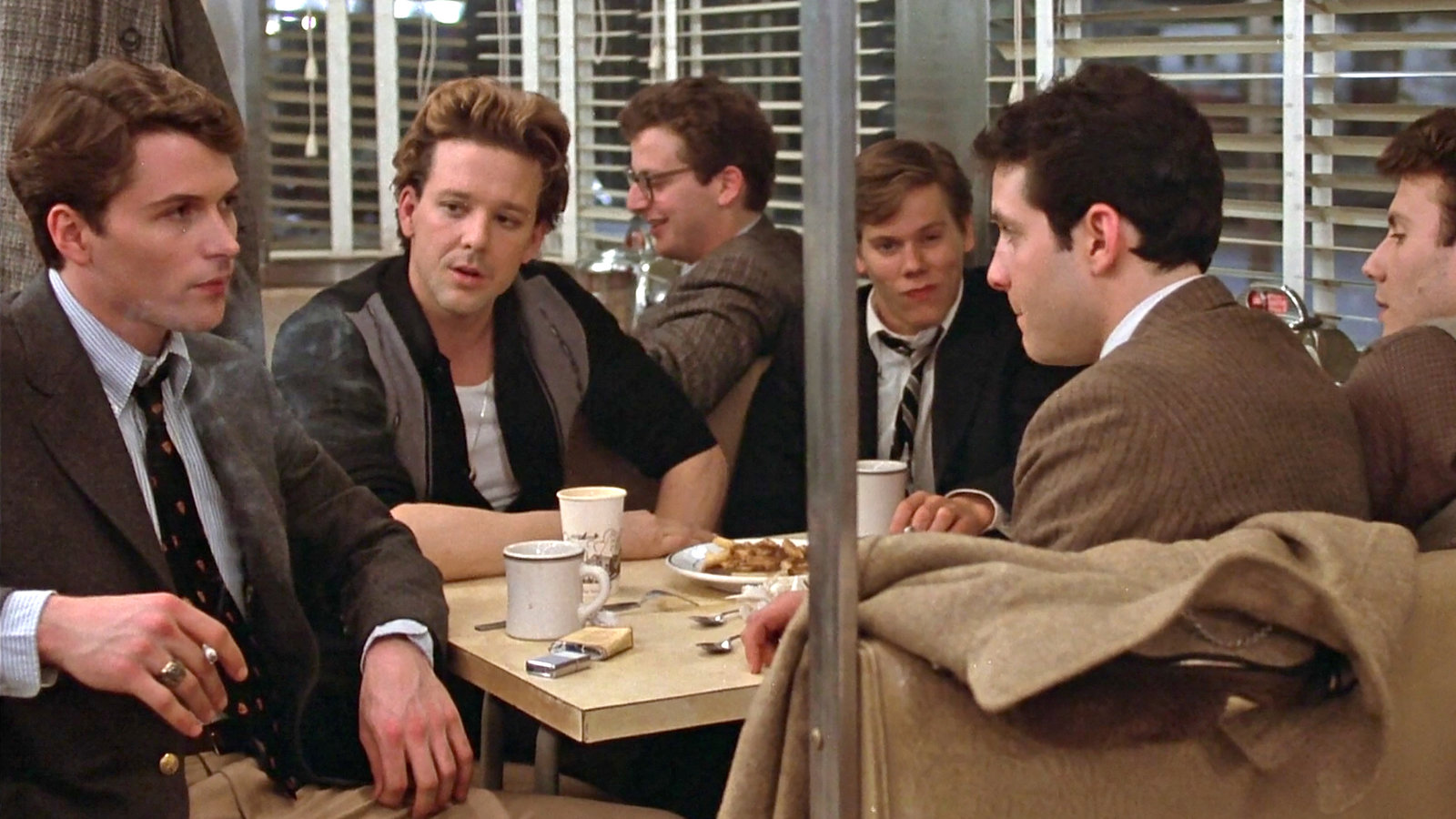
Since it’s Thanksgiving weekend, that most venerable of American holidays which enables families to gather once a year to count their blessings, stuff their faces, and endeavor mightily to not bring politics into the conversation, I thought I might mosey on over to the movie pantry and hand-select my top 10 food films. Dig in!

Big Night– I have frequently foisted this film on friends and relatives, because after all, it’s important to “…take a bite out of the ass of life!” (as one of the characters demonstrates with voracious aplomb). Two brothers, enterprising businessman Secondo (Stanley Tucci, who also co-wrote and co-directed) and his older sibling Primo (Tony Shalhoub), a gifted chef, open an Italian restaurant but quickly run into financial trouble.
Possible salvation arrives via a dubious proposal from a more successful competitor (played by a hammy Ian Holm). The fate of their business hinges on Primo’s ability to conjure up the ultimate feast. And what a meal he prepares-especially the timpano (you’d better have pasta and ragu handy-or your appestat will be writing checks your duodenum will not be able to cash, if you know what I’m saying).
The wonderful cast includes Isabella Rossellini, Minnie Driver, Liev Schreiber, Allison Janney, Campbell Scott (who co-directed with Tucci), and look for Latin pop superstar Marc Anthony as the prep cook.

Comfort and Joy– A quirky trifle from Scottish writer-director Bill Forsyth (Gregory’s Girl, Local Hero). An amiable Glasgow radio DJ (Bill Paterson) is dumped by his girlfriend on Christmas Eve, throwing him into existential crisis and causing him to take urgent inventory of his personal and professional life. Soon after lamenting to his GM that he yearns to produce something more “important” than his chirpy morning show, serendipity lands him a hot scoop-a brewing “war” between two rival ice-cream dairies.
The film is chockablock with Forsyth’s patented low-key anarchy, wry one-liners and subtle visual gags. As a former morning DJ, I can attest the scenes depicting “Dickie Bird” running his show are authentic (a rarity on the screen). One warning: it might take several days for you to purge that ice cream van’s loopy theme music out of your head.

The Cook, the Thief, His Wife, and Her Lover– A gamey, visceral and perverse fable about food, as it relates to love, sex, violence, revenge, and Thatcherism from writer-director Peter Greenaway (who I like to call “the thinking person’s Ken Russell”).
Michael Gambon (who passed away earlier this year) chews up the scenery as a vile and vituperative British underworld kingpin who holds nightly court at a gourmet eatery. When his bored trophy wife (Helen Mirren) becomes attracted to one of the regular diners, an unassuming bookish fellow (Alan Howard), the wheels are set in motion for a twisty tale, culminating in one of the most memorable scenes of “just desserts” ever served up on film (not for the squeamish).
The opulent set design and cinematographer Sacha Vierny’s extraordinary use of color lend the film a rich Jacobean texture. Richard Bohringer is “the cook”, and look for the late pub rocker Ian Dury as one of Gambon’s associates. It’s unique…if not for all tastes.

Diner– This slice-of-life dramedy marked writer-director Barry Levinson’s debut in 1982, and remains his best. A group of 20-something pals converge for Christmas week in 1959 Baltimore. One is recently married, another is about to get hitched, and the rest playing the field and deciding what to do with their lives as they slog fitfully toward adulthood.
The most entertaining scenes are at the group’s favorite diner, where the comfort food of choice is French fries with gravy. Levinson has a knack for writing sharp dialog, and it’s the little details that make the difference; like a cranky appliance store customer who will settle for nothing less than a B&W Emerson (he refuses to upgrade to color TV because he saw Bonanza in color at a friend’s house, and thought “…the Ponderosa looked fake”).
This film was more influential than it gets credit for; Tarantino owes a debt, as do the creators of Seinfeld. It’s hard to believe that Kevin Bacon, Mickey Rourke, Ellen Barkin, Daniel Stern, Timothy Daly, Steve Guttenberg and Paul Reiser were all relative unknowns at the time!

Eat Drink Man Woman– Or as I call it: “I Never Stir-Fried for My Father”. This was director Ang Lee’s follow-up to his surprise hit The Wedding Banquet (another good food flick). It’s a well-acted dramedy about traditional Chinese values clashing with the mores of modern society. An aging master chef (losing his sense of taste) fastidiously prepares an elaborate weekly meal which he requires his three adult, single daughters to attend. As the narrative unfolds, Lee subtly reveals something we’ve suspected all along: when it comes to family dysfunction, we are a world without borders.

My Dinner with Andre– This one is a tough sell for the uninitiated. “An entire film that nearly all takes place at one restaurant table, with two self-absorbed New York intellectuals pontificating for the entire running time of the film-this is entertaining?!” Yes, it is. Director Louis Malle took a chance that pays off in spades. Although essentially a work of fiction, the two stars, theater director Andre Gregory and actor-playwright Wallace Shawn are playing themselves (they co-wrote the screenplay). A rumination on art, life, love, the universe and everything, the film is not so much about dinner, as a love letter to the lost art of erudite dinner conversation.
Pulp Fiction– Although the universal popularity of this Quentin Tarantino opus is owed chiefly to its hyper-stylized mayhem and the iambic pentameter of its salty dialogue, I think it is underappreciated as a foodie film. The hell you say? Think about it.
The opening and closing scenes take place in a diner, with characters having lively discussions over heaping plates of food. In Mia and Vincent’s scene at the theme restaurant, the camera zooms to fetishistic close-ups of the “Douglas Sirk steak, and a vanilla coke.” Mia offers Jules a sip of her 5 Dollar Milkshake.
Vincent and Jules ponder why the French refer to Big Macs as “Royales with cheese” and why the Dutch insist on drowning their French fries in mayonnaise. Jules voraciously hijacks the doomed Brett’s “Big Kahuna” burger, then precedes to wash it down with a sip of his “tasty beverage”. Pouty Fabienne pines wistfully for blueberry pancakes.
Even super-efficient Mr. Wolfe takes a couple seconds out of his precisely mapped schedule to reflect on the pleasures of a hot, fresh-brewed cup of coffee. And “Don’t you just love it when you come back from the bathroom and find your food waiting for you?”

Tampopo– Self billed as “The first Japanese noodle western”, this 1987 entry from writer-director Juzo Itami is all that and more. Nobuko Niyamoto is superb as the title character, a widow who has inherited her late husband’s noodle house. Despite her dedication and effort to please customers, Tampopo struggles to keep the business afloat, until a deux ex machina arrives-a truck driver named Goro (Tsutomo Yamazaki).
After one taste, Goro pinpoints the problem-bland noodles. No worries-like the magnanimous stranger who blows into an old western town (think Shane), Goro takes Tampopo on as a personal project, mentoring her on the Zen of creating the perfect noodle bowl. A delight from start to finish, offering keen insight on the relationship between food, sex and love.

The Trip– Pared down into feature film length from the BBC series of the same name, Michael Winterbottom’s film is essentially a highlight reel of that show-which is not to denigrate; as it is the most genuinely hilarious comedy I’ve seen in many a moon. The levity is due in no small part to Winterbottom’s two stars-Steve Coogan and Rob Brydon, basically playing themselves in this mashup of Sideways and My Dinner with Andre.
Coogan is asked by a British newspaper to take a “restaurant tour” of England’s bucolic Lake District, and review the eateries. He initially plans to take his girlfriend along, but since their relationship is going through a rocky period, he asks his pal, fellow actor Brydon, to accompany him.
This simple setup is an excuse to sit back and enjoy Coogan and Brydon’s brilliant comic riffing (much of it improvised) on everything from relationships to the “proper” way to do Michael Caine impressions. There’s some unexpected poignancy-but for the most part, it’s pure comedy gold. It was followed by three equally entertaining sequels, The Trip to Italy (2014), The Trip to Spain (2017), and The Trip to Greece (2020).

Tom Jones– The film that made the late Albert Finney an international star, Tony Richardson’s 1963 romantic comedy-drama is based on the Henry Fielding novel about the eponymous character’s amorous exploits in 18th-Century England.
Tom (Finney) is raised as the bastard son of a prosperous squire. He is a bit on the rakish side, but wholly lovable and possesses a good heart. It’s the “lovable” part that gets him in trouble time and again, and fate and circumstance put young Tom on the road, where various duplicitous parties await to prey upon his naivety.
John Osborne adapted the Oscar-winning script; the film also won for Best Picture, Director, and Music Score (Finney was nominated for Best Actor).
The film earns its spot on this list for a brief but iconic (and very tactile) eating scene involving Finney and the wonderful Joyce Redman (see below).
Bon Appétit!
Previous posts with related themes:
More reviews at Den of Cinema
— Dennis Hartley